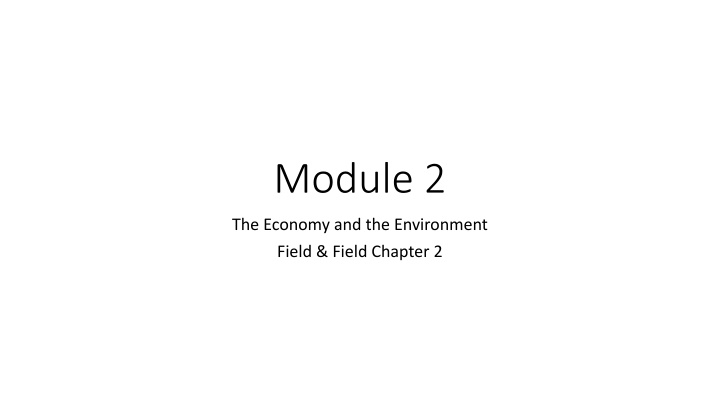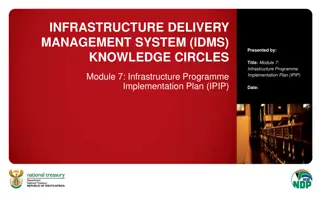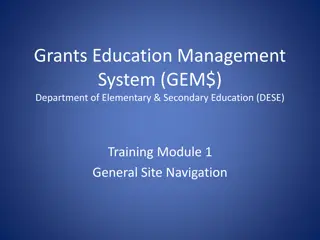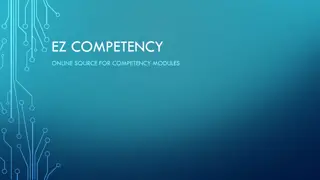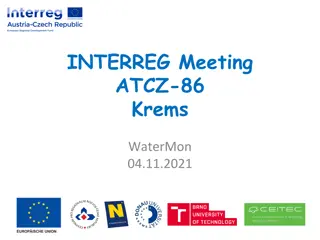Module 2
Environmental economics applies economic principles to the management of environmental resources, focusing on decision-making affecting the natural environment and ways to improve environmental quality through economic policies. Explore how the economy interacts with the environment, the trade-offs between economic output and environmental quality, and the concept of the Production Possibility Frontier (PPF) in balancing market goods and environmental assets.
Download Presentation

Please find below an Image/Link to download the presentation.
The content on the website is provided AS IS for your information and personal use only. It may not be sold, licensed, or shared on other websites without obtaining consent from the author.If you encounter any issues during the download, it is possible that the publisher has removed the file from their server.
You are allowed to download the files provided on this website for personal or commercial use, subject to the condition that they are used lawfully. All files are the property of their respective owners.
The content on the website is provided AS IS for your information and personal use only. It may not be sold, licensed, or shared on other websites without obtaining consent from the author.
E N D
Presentation Transcript
Module 2 The Economy and the Environment Field & Field Chapter 2
Defining Environmental Economics Environmental economics is the application of the principles of economics to the study of how environmental resources are managed It focuses primarily on how and why people make decisions that have consequences for the natural environment Also concerned with how economic institutions and policies can be changed to consider environmental quality Related fields: Mineral Economic Energy Economics Water Economics Marine Economics Forest Economics Agricultural Economics Land Economics
The Economy and the Environment Fig 1: The economy and the environment The economic functions of production and consumption occur within the natural environment. Natural resource economics is the study of nature as the provider of raw materials and energy inputs (a) The impact of economic activity on the quality of the natural environment is called environmental economics (b) Nature a b Economy
The Environment: An Economic and Social Asset Inputs of natural resources are important in economic production Environment quality can be thought of as a productive asset for a society In other words, there is a trade off between conventional economic output and environmental quality Fig 2 shows a PPF which is a curve showing the different combinations of two things a society can produce at any given time, given its resources and technological capabilities This is nearly identical to a PPF model of producing capital goods and consumer goods.
The PPF: Trade-off between environmental quality and market goods Fig 2 (a) PPF today Fig 2 (b): PPF in 60 years Market goods Market goods C2 C4 C3 C1 e2 e1 e4 e3 Environmental Quality Environmental Quality
The PPF for Market Goods and Environmental Quality The PPF shows the different combinations of market output and environmental quality that are available to a group of people who have a fixed endowment of resources and technology In fig 2 (a) If the current level of economic output is C1, and increase to C2 can be obtained only at the cost of a decrease in environmental quality Where society chooses to locate itself on the PPF is a matter of social choice In fig 2 (b) shows that degrading the environment too much today will affect future possibilities and PPF will shift inwards. Future generations can have the same level of output as present generation but only at a lower level of environmental quality
The Fundamental Balance of Materials The Fundamental Balance Phenomenon says that in the long run all materials taken out of the natural system by human beings must eventually end up back in the system. M = Rdp+ Rdc Where M = Raw materials extracted Rdp= discharged producer residuals Rdc= discharged consumer residuals Economy is divided into two broad segments (producers and consumers) Production and consumption create residuals which may be emitted into the air or water or land The implication is that to reduce the mass of residuals disposed into the environments, it is necessary to reduce the level of raw materials into the system
The Fundamental Balance 2 Rdp+ Rdc= M = G + Rp Rrp Rrc This says that the quantity of raw materials (M) is equal to the output of goods and services (G) plus production residuals (Rp) minus the amounts that are recycled from producers (Rrp) and consumers (Rrc) This leaves us three ways of reducing M Reduce G Reduce RP Increase RrpRrc
The natural environment cycle gets more complex when we consider and economy with many producers with different Resource needs Production processes Outputs Abilities to reuse/recycle Residual streams Effluent streams
Renewable Resources Face a maximum rate of regeneration. Optimal allocation across time is a function of Sustainability Cost of capture Productivity of use Examples Solar and Wind power Fisheries (ecological cycles, natural resource preservation) Forests Ozone & GHG absorptive capacity
Non-Renewable Resources Will eventually be depleted or severely limited in availability. Optimal allocation across time is a function of Availability of close substitutes Cost of extraction Value in the production process Works like a finance problem Examples Oil Natural Gas Minerals
Emissions, ambient quality, & damages, fig2.3 We need to consider the source of our concern. Are we concerned only about the effect on humans? Is there also concern for the environment itself? If we are concerned only about humans, the discussion turns rapidly to elasticities and substitution. This is both a philosophical and a practical question. Mechanistic view of society Organic view of society
Types of pollutants Cumulative vs. non-cumulative Local, regional, global Point source vs. non-point (mobile) source Continuous vs episodic (discharge rates) Non-emission damage: strip mining, habitat destruction, etc.
Summary The topic explored some basic linkages between the economy and the environment Discussed the trade-offs between conventional economic goods and environmental quality between current and future generations using the PPF Introduced the fundamental balance phenomenon and how we might reduce residuals from production and consumption
